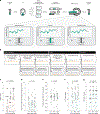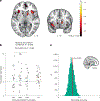Nicotine-related beliefs induce dose-dependent responses in the human brain
- PMID: 39463822
- PMCID: PMC11512134
- DOI: 10.1038/s44220-023-00188-9
Nicotine-related beliefs induce dose-dependent responses in the human brain
Abstract
Beliefs have a powerful influence on our behavior, yet their neural mechanisms remain elusive. Here we investigate whether beliefs could impact brain activities in a way akin to pharmacological dose-dependent effects. Nicotine-dependent humans were told that nicotine strength in an electronic cigarette was either 'low', 'medium' or 'high', while nicotine content was held constant. After vaping, participants underwent functional neuroimaging and performed a decision-making task known to engage neural circuits affected by nicotine. Beliefs about nicotine strength induced dose-dependent responses in the thalamus, a key binding site for nicotine, but not in other brain regions such as the striatum. Nicotine-related beliefs also parametrically modulated the connectivity between the thalamus and ventromedial prefrontal cortex, a region important for decision-making. These findings reveal a high level of precision in the way beliefs influence the brain, offering mechanistic insights into humans' heterogeneous responses to drugs and a pivotal role of beliefs in addiction.
Figures




References
-
- Posner MI, Petersen SE, Fox PT & Raichle ME Localization of cognitive operations in the human brain. Science 240, 1627–1631 (1988). - PubMed
-
- Kirsch I Response expectancy as a determinant of experience and behavior. Am. Psychol 40, 1189–1202 (1985).
Grants and funding
LinkOut - more resources
Full Text Sources
